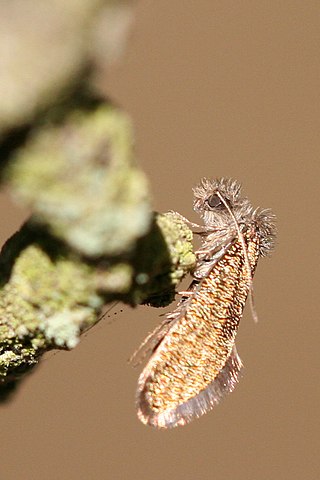
An oak is a hardwood tree or shrub in the genus Quercus of the beech family, Fagaceae. They have spirally arranged leaves, often with lobed edges, and a nut called an acorn, borne in a cup. The genus is widely distributed in the Northern Hemisphere; it includes some 500 species, both deciduous and evergreen. Fossil oaks date back to the Middle Eocene. Molecular phylogeny shows that the genus is divided into Old World and New World clades, but many oak species hybridise freely, making the genus's history difficult to resolve.

Quercus muehlenbergii, the chinquapinoak, is a deciduous species of tree in the white oak group. The species was often called Quercus acuminata in older literature. Quercus muehlenbergii is native to eastern and central North America. It ranges from Vermont to Minnesota, south to the Florida panhandle, and west to New Mexico in the United States. In Canada it is only found in southern Ontario, and in Mexico it ranges from Coahuila south to Hidalgo.

Quercus robur, the pedunculate oak, is a species of flowering plant in the beech and oak family, Fagaceae. It is a large tree, native to most of Europe and western Asia, and is widely cultivated in other temperate regions. It grows on soils of near neutral acidity in the lowlands and is notable for its value to natural ecosystems, supporting a very wide diversity of herbivorous insects and other pests, predators and pathogens.

Quercus ilex, the evergreen oak, holly oak or holm oak is a large evergreen oak native to the Mediterranean region. It is a member of the Ilex section of the genus, with acorns that mature in a single summer.

Quercus petraea, commonly known as the sessile oak, Cornish oak, Irish Oak or durmast oak, is a species of oak tree native to most of Europe and into Anatolia and Iran. The sessile oak is the national tree of Ireland, and an unofficial emblem in Wales and Cornwall.

Quercus agrifolia, the California live oak, or coast live oak, is a highly variable, often evergreen oak tree, a type of live oak, native to the California Floristic Province. It may be shrubby, depending on age and growing location, but is generally a medium-sized tree. It grows west of the Sierra Nevada mountain range from Mendocino County, California, south to northern Baja California in Mexico. It is classified in the red oak section of oaks.

Quercus douglasii, known as blue oak, is a species of oak endemic to California, common in the Coast Ranges and the foothills of the Sierra Nevada. It is California's most drought-tolerant deciduous oak, and is a dominant species in the blue oak woodland ecosystem. It is occasionally known as mountain oak and iron oak.

An oak savanna is a type of savanna—or lightly forested grassland—where oaks are the dominant trees. The terms "oakery" or "woodlands" are also used commonly, though the former is more prevalent when referencing the Mediterranean area. These savannas were maintained historically through wildfires set by lightning, humans, grazing, low precipitation, and/or poor soil.

Dyseriocrania subpurpurella is a diurnal moth from the family Eriocraniidae, found in most of Europe. The moth was first named by the English entomologist, Adrian Hardy Haworth in 1828.

The Thyatirinae, or false owlet moths, are a subfamily of the moth family Drepanidae with about 200 species described. Until recently, most classifications treated this group as a separate family called Thyatiridae.

Quercus mongolica, commonly known as Mongolian oak, is a species of oak native to Japan, China, Korea, Mongolia, and Siberia. The species can grow to be 30 metres tall.

Polyploca ridens, the frosted green, is a moth of the family Drepanidae. It is found in southern and central Europe, England, Denmark, southern Sweden and in the east up to Russia.
Parabatella is a monotypic moth genus in the subfamily Lymantriinae erected by Ugo Dall'Asta in 1981. Its only species, Parabatella polyploca, was first described by Cyril Leslie Collenette in 1960. It is found in the Democratic Republic of the Congo.

Chesistege is a genus of moths in the family Geometridae. It contains only one species, Chesistege korbi, which is found in Turkey, Armenia and Turkmenistan.

Castalin is an ellagitannin. It can be found in oak wood and in Melaleuca quinquenervia leaves.
Rectiostoma fernaldella is a species of moth in the family Depressariidae. It was described by Riley in 1889. It is found in North America, from southern Mexico to the eastern basin and range area in southern Arizona and disjunctly to California. There is also a record for Tennessee.
Polyploca laororshanae is a moth in the family Drepanidae. The habitat of P. laororshanae is located in northern Israel and possibly Lebanon and Syria, although this remains unclear. The habitat consists of clearings and the fringes of evergreen sclerophyllous maquis on limestone.

Polyploca is a genus of moths belonging to the subfamily Thyatirinae of the Drepanidae.
Epipsestis nigropunctata is a moth in the family Drepanidae. It is found in China, Japan, Korea, the Russian Far East and Nepal.
Iberodorcadion korbi is a species of longhorned beetle in the family Cerambycidae. It is found in Spain.












